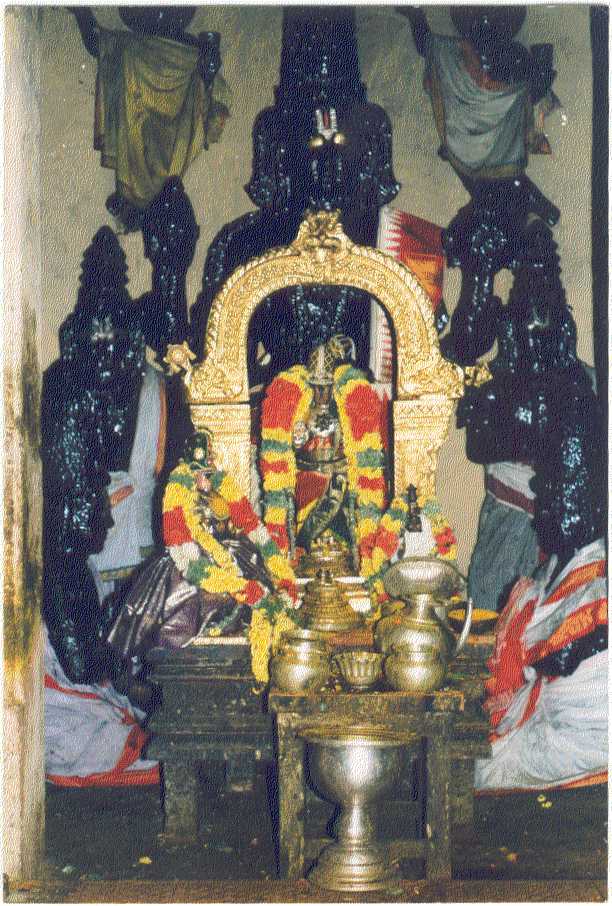Today’s [28th May, 2007] lecture also is courtesy Smt and Sri Vedantham.
Thirumangai Alwar has mentioned this Kshetram in his Periya Thirumadal compilation. He mentions a number of kshetrams in a single hymn- Thiruvegadam [Thirumala], Thirukkoyilur, Kanchi, Ooragam, Peragam, Thiruvellarai and Vekkha. Both Periyalwar and Thirumangai Alwar have composed songs in praise of Sri Pundareekaksha Perumal of this Kshetram. Very near the temple in a forest surrounding is an ancient mandapam. Once this was the cave where Sage Markandeya lived and meditated. The Lord here appeared before Markandeya and King Sibi. We can research into His eyes. They are black, broad, bright, red lines running and long, which captivated Thiruppanalwar. The eyes are long and broad and resemble the just blossomed lotus flower. They look at the devotees and are ever ready to shower His grace and mercy. Upanishads claim He is the Purushothama [God] Who has the Lotus like Eyes. This is what is described by Swami Ramanuja. Brim full water in a lake and in the middle is a lotus with very long and stout stem. The lotus has thousand petals and, in the center, golden hued pollens and it is blossomed by the rays of the Sun. The Lord’s eyes resemble such a lotus. The same Lord as Sri Krishna is preaching Gita. In the 42nd sloka, He mentioned that some Vedic Pundits claim in flowery language that swarga is the ultimate goal for the atman. In the 43rd sloka He explains how all these karmas will lead one to earthly wealth only. In the 44th sloka, He says that such people, who pursue karmas for worldly wealth, will never realize the real nature of atman. If one understands atman is different from body, one will not give that importance to the body. But these worldly wealth are all related to body only. Therefore, these karmas will enable only recurring births and remain in the birth cycle. So, atman chinthana or contemplating on atman is necessary to break away from this cycle. This step will lead to reaching Brahman or God. These people are not going to get the wisdom, if they are absorbed in karmas leading to swarga. Which wisdom? The wisdom or gyana that atman and body are different, that the atman is eternal and indestructible, that the atman nature is everlasting happiness and that the atman is servant of the Lord. Thiruppanalwar describes in his Amalanadhipiran in the 3rd hymn, mandhi pai vada venkata.. We see a tree here. Lots of birds perch and eat the fruits. After the fruits are exhausted, they migrate to another tree. When we go to Thirumala we notice monkeys. They jump from one tree to another. The monkeys mentioned by Alwar in the hymn are people like us, our Acharyas emphatically mention. Because we possess same qualities. Just as monkeys jump off from one tree after exhausting the fruits, we also seek various boons from the Lord Venkatesa. The Lord also thinking that next time that person might pray for Moksham, grants the smaller desires. But that person comes with more earthly desires next time. A villager visited a city. His friends cautioned him that in the city you should purchase anything only after bargaining. They told that he should bargain for 50% of the seller’s price. He came to the city and wanted to purchase an article and the seller demanded Rs.100. villager remembered the advice of his friends and bargained for Rs.50. The seller felt it was too low and said he would agree for Rs.70. Immediately, the villager asked for Rs.35. Puzzled the seller said he may as well give it free. Quick came the bargain from the villager; whether he would give two such articles! In a similar way we never get satisfied with what we have and our demands are ever growing. Like the monkeys hopping tree after tree. The fire in yagna is called anala. It will consume anything without a limit. Our mind also is in a way like that, never satisfied with what was given. We never say enough for the accumulation of wealth. We should earn to give the needy and poor. But we accumulate for our children without a limit. Our mind is trained to calculate how much more we should earn and how to amass wealth. We surely know what is enough for us, but we are greedy and want to amass more and more. If only we could devote our attention to the welfare of atman instead of body, we would have achieved great results. We are comforting the body in shade while allowing the atman to suffer in the hot sun. That is we are keeping the body in wealth and comforts. It should be the other way. But we never do that and our mind is engaged in these worldly wealth and happiness all the time losing even our sleep. Sri Krishna therefore tells Arjuna that by thinking of these earthly pleasures and planning how to attain, such minds have no scope for thinking what is good for the soul. Naturally, they can never do karma yoga and consequently, Moksham is denied to them. That means they will be in the birth-death cycle and earn papa and punya. To expend these more and more births will be needed. So only by doing one’s duty with detachment and determination, one can come away from the cycle of births. This is the substance of 44th sloka.


